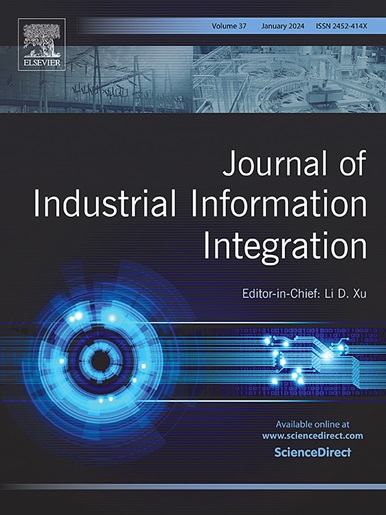利用先进的智能体系结构对玉米生长进行病害识别和产量预测
IF 10.4
1区 计算机科学
Q1 COMPUTER SCIENCE, INTERDISCIPLINARY APPLICATIONS
引用次数: 0
摘要
玉米因其巨大的经济价值、有益健康和对人类的营养作用而成为全球重要的粮食植物。人工智能(AI)在农业领域的应用取得了进展,但提高机器效率、速度和生产力的视觉系统仍有待提高。从种植到收获的玉米生长管理和早期病害诊断影响产量、质量和盈利能力。本研究通过玉米生长阶段(CGS)的初步基准评估,提供玉米新型综合叶病(CCLD)数据,帮助预测生长和估计总体损害和损失。其次,提出了一种具有新颖的高级池化层和PO-GELU功能(PS-VT+ APL)的Swin Vision变压器。这消除了噪声,降低了计算量,最小化了尺寸,捕获了最有利的局部特征,有助于优化损失函数,并优化效率。第三,PS-VT+ APL成功预测了玉米病日(CDDT)检测的最佳时间,准确率为99.21%。利用玉米叶片病害类型(CLST)集进行病害类型识别,效率为96.12%。此外,确定识别每种玉米病害的最佳时机也是至关重要的。最后,PS-VT+APL能够及时、彻底地识别和区分生长过程中玉米病害的复杂症状,得分最高(99.82%)。此外,它比基线方法更有效,所需时间更少。推荐的方法提高了玉米系统的自动化,同时通过各种操作实现了卓越的效率。它可以与自喷系统和无人驾驶飞行器(uav)等实时系统协同工作,并且足够灵活,可以管理各种与玉米相关的工作。这项研究的发现有利于各个领域,包括决策、疾病管理、时间敏感的收获计划、开发方法和玉米机器人视觉。本文章由计算机程序翻译,如有差异,请以英文原文为准。

Monitoring corn growth with disease identification and yield prediction via advanced intelligent architecture
Corn is a vital food plant globally due to its significant financial value, beneficial wellness, and nutritional effects on humanity. The implementation of artificial intelligence (AI) in agriculture has progressed, but the vision systems, which promote machine efficiency, speed, and productivity, remain to be raised. Managing corn growth from planting to harvest and early disease diagnosis impacts yield, quality, and profitability. This research assists in anticipating growth and estimating overall damage and loss by providing New Comprehensive Corn Leaf Diseases (CCLD) data via Corn Growth Stages (CGS) with initial benchmark evaluations. Secondly, it proposed a Swin Vision Transformer with a novel Advanced Pooling Layer and PO-GELU function (PS-VT+ APL). This eliminates noise, lowers the computational burden, minimizes dimensions, captures the most beneficial local features, helps to optimize the loss functions, and optimizes efficiency. Thirdly, PS-VT+ APL successfully predicts the best time for Corn Diseased Daytime (CDDT) detection with an accuracy of 99.21%. It also efficiently identifies disease types using the Corn Leaf Diseases Types (CLST) set with an efficiency of 96.12%. In addition, it is essential to determine the best moment to identify each kind of corn disease. Finally, PS-VT+APL promptly and thoroughly recognizes and distinguishes complicated symptoms of corn diseases during growth, with the highest score (99.82%). Furthermore, it works more effectively and requires less time than the baseline methods. The recommended approach boosts the automation of corn systems while simultaneously achieving excellent effectiveness through a variety of operations. It can work in conjunction with real-time systems such as self-spraying systems and unmanned aerial vehicles (UAVs) and is flexible enough to manage a wide range of corn-related jobs. This study's findings benefit various areas, including decision-making, disease management, time-sensitive harvesting schedules, development methods, and corn robotic vision.
求助全文
通过发布文献求助,成功后即可免费获取论文全文。
去求助
来源期刊

Journal of Industrial Information Integration
Decision Sciences-Information Systems and Management
CiteScore
22.30
自引率
13.40%
发文量
100
期刊介绍:
The Journal of Industrial Information Integration focuses on the industry's transition towards industrial integration and informatization, covering not only hardware and software but also information integration. It serves as a platform for promoting advances in industrial information integration, addressing challenges, issues, and solutions in an interdisciplinary forum for researchers, practitioners, and policy makers.
The Journal of Industrial Information Integration welcomes papers on foundational, technical, and practical aspects of industrial information integration, emphasizing the complex and cross-disciplinary topics that arise in industrial integration. Techniques from mathematical science, computer science, computer engineering, electrical and electronic engineering, manufacturing engineering, and engineering management are crucial in this context.
 求助内容:
求助内容: 应助结果提醒方式:
应助结果提醒方式:


